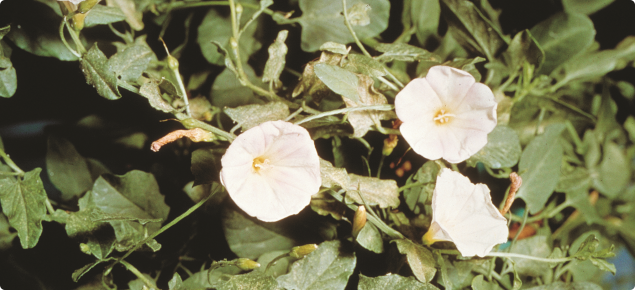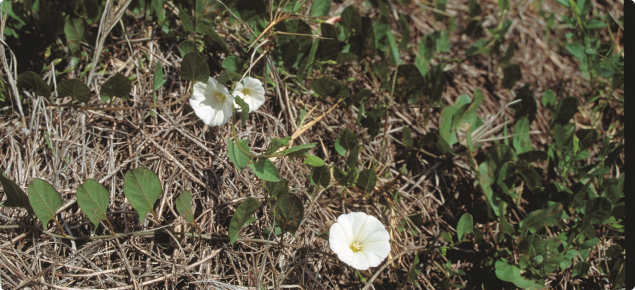Form: herbaceous vine — perennial
Status: present in WA
Field bindweed is also known as morning glory and wild morning glory, however it should not be confused with the common garden morning glory vines (Ipomoea species). It originated in Europe and spread to become a major problem in North America, South Africa and New Zealand. It has been established in Victoria since the 1890s and occasional infestations have been found in Western Australia.
Field bindweed prefers deep, fertile alkaline soils and medium rainfall conditions, but will grow under a wide range of soils and climates. However it is quickly killed by waterlogging.
Appearance
Field bindweed is a trailing prostrate twining plant. Stems are long, slender, pale-green in colour and branched. They grow up to two metres long.
Leaves: Arrow-shaped with rounded basal lobes and few hairs. They are arranged alternately on the stems.
Flowers: White to pink, funnel-shaped and up to three centimetres in diameter. They have a long flower stalk. Flowers open in sunlight and close in shade.
Fruit: A capsule that contains two to four grey-brown triangular seeds.
Seeds: Three to five millimetres in length with a rough speckled coat. The seed has a hard coat which delays water absorption and may delay germination for up to 40 years.
New plants germinate in the spring and flower during the summer. The foliage dies in the autumn. A taproot develops rapidly after germination and may penetrate to three metres deep in suitable soils. Horizontal roots stay near the surface and produce buds which give rise to new stems.
Agricultural and economic impact
Field bindweed is a nuisance in orchards and vineyards. It competes with crop plants for soil moisture and, to a lesser extent, for light. It tangles with cereal crops, weighing them down and interfering with harvesting. Field bindweed has no feed value and may make stock vomit. Difficult to control once plants are established due to regeneration from rhizomes (underground stems). Only seedlings and young plants are susceptible to herbicides.
Legal status
The Western Australian Organism List (WAOL) contains information on the area(s) in which this pest is declared and the control and keeping categories to which it has been assigned in Western Australia (WA). Search for field bindweed in WAOL using the scientific name of Convolvulus arvensis.
Search > detect > report
| MyPestGuide™ Reporter | Pest and Disease Information Service (PaDIS) |
Control method
When using any agricultural chemicals please ensure that you always follow instructions on the label and any permit. Users of agricultural chemical products must always strictly comply with the directions on the label and the conditions of any permit.
Only registered products can be used for weed and pest control.
Control methods for this plant can be found through the APVMA website, use "field bindweed" as the pest name.


